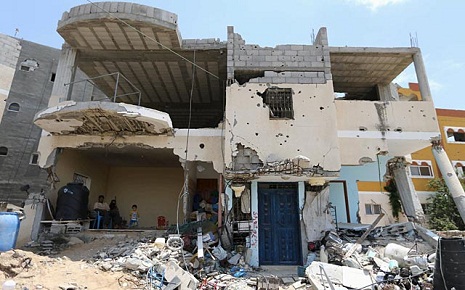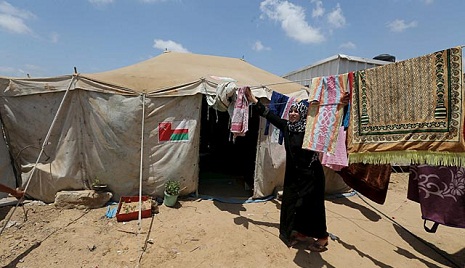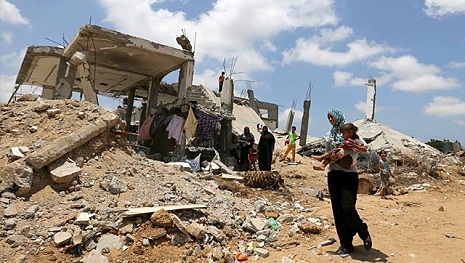Thousands of homes in Gaza that were destroyed during the war still have not been rebuilt, forcing residents to construct makeshift houses where they once lived out of prefabricated supplies or rubble.
The slow pace of reconstruction has frustrated residents
The delay has been blamed on a variety of reasons, including Israel`s strict blockade preventing the shipment of construction material into the coastal enclave and the failure of promised money to arrive from international donors.

Members of a Palestinian family sit inside the remains of their house
The result has been Gazans seeking to house their families in whatever way they can, with some 18,000 homes either destroyed or severely damaged during the 50-day war.
Here is a brief overview of the Palestinian coastal enclave run by Islamist movement Hamas and the challenges it faces:
Overpopulation
Situated on the Mediterranean coast, flanking Israel and Egypt, the Gaza Strip is home to 1.8 million Palestinians who live in an area stretching just 362 square kilometres (140 square miles), making it one of the most densely populated territories on the planet.
Of the population that is growing by 50,000 a year - nearly two-thirds are dependent on aid in some form or another.
Hamas in power
Israel seized the territory from Egypt during the 1967 Six-Day War, but pulled out all of its soldiers and settlers in a unilateral move in 2005.
Within six months of the withdrawal, Gaza became the de facto seat of Hamas after the Islamist movement won a landslide victory in Palestinian parliamentary elections. Its victory led to tensions with its rival Fatah, which had previously monopolised the political scene, dominates the Western-backed Palestinian Authority, and is in power in the West Bank.
Israeli blockade
In the summer of 2006, following the capture of a soldier by militants from Hamas, Israel imposed a blockade on Gaza which was tightened a year later after the Islamists forcibly ousted troops loyal to Palestinian president Mahmud Abbas`s Fatah.
Poverty
The Gaza Strip has almost no industry, with exports banned under the Israeli blockade. Since the end of the war, the flow of reconstruction materials into the territory has been greatly restricted, with Israel insisting on tight monitoring of all imports of cement, iron and other materials that could be employed by Hamas to rebuild secret tunnels that were used to attack Israel. So slow has the influx of goods been that the United Nations last week said it could take 30 years to rebuild the damage.

A Palestinian woman looks on as she stands in front of the ruins of her house
Last month, the International Monetary Fund described Gaza`s economy as being on the verge of collapse, with unemployment nearing 45 %, GDP down 15 % in 2014 and the once-strong manufacturing sector dying.
Some 39 percent of the population live below the poverty line. Even before last year`s war, two-thirds of the population depended on food aid and more than 40 percent were unemployed.
The question of unity
Under pressure from a growing economic crisis in Gaza, and increasingly isolated within the region, Hamas signed a surprise reconciliation deal with its West Bank rivals in April 2014 which led to the creation of a national unity government.
But in practice the unity government has never ruled and disputes over the payment of Hamas-appointed employees in Gaza, and control of the territory, mean Hamas remains in control there.
There is talk of Hamas offering Israel a long-term truce, which would free up the flow of goods and people across their shared border. In recent weeks, up to 2,000 Gazans a day have been crossing, a marked increase from a trickle months ago.
Qatar, a major financial supporter of Hamas, has nearly completed the construction of a new road along the beachfront and has other projects in the pipeline. Yet there are threats.
Militant Salafist groups claiming ties to IS have started to agitate in Gaza, firing occasional rockets into Israel and carrying out attacks. They have threatened to overthrow Hamas and the rival Fatah party. As well as a threat to Palestinian authority, they are of deep concern to Egypt and Israel.
Gaza is the United Nation`s longest-running relief operation, set up in 1949. The head of those operations, Robert Turner, will leave his post next month after three years in Gaza. Since the war, he has been witheringly critical of the obstacles to reconstruction. But ahead of his departure, he tried to sound a positive note.
"I refuse to yield to pessimism," he said. "Gaza is a place where the human spirit has shown its indomitability time and time again."

A Palestinian woman collects laundry near the ruins of her house.
The major problem is that Gazans have become so adept at getting by - finding a way to deal with up to 16 hours of power cuts a day, smuggling in everything from live animals to cars via tunnels, scraping together an existence amid militant rule and war - that people have begun to regard the extraordinary as normal.
















































